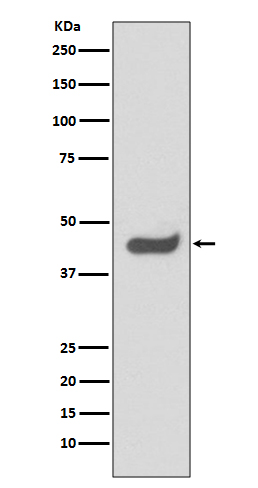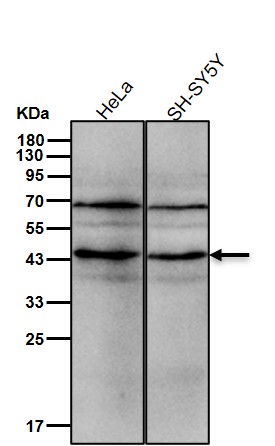

| WB | 1/1000-1/2000 | Human,Mouse,Rat |
| IF | 咨询技术 | Human,Mouse,Rat |
| IHC | IHC:1/100-1/200;IHF:1/50-1/200 | Human,Mouse,Rat |
| ICC | 1/50-1/200 | Human,Mouse,Rat |
| FCM | 咨询技术 | Human,Mouse,Rat |
| Elisa | 咨询技术 | Human,Mouse,Rat |
| Aliases | Sex determining region Y box 1; sox1; SRY; SRY box containing gene 1; SRY related HMG box gene 1; Transcription factor Sox-1;;SOX1 |
| WB Predicted band size | 39 kDa |
| Host/Isotype | Rabbit IgG |
| Antibody Type | Primary antibody |
| Storage | Store at 4°C short term. Aliquot and store at -20°C long term. Avoid freeze/thaw cycles. |
| Species Reactivity | Human,Mouse |
| Immunogen | A synthesized peptide derived from human SOX1 |
| Formulation | Purified antibody in PBS with 0.05% sodium azide,0.05% BSA and 50% glycerol. |
+ +
以下是关于SOX1抗体的3篇参考文献概览(文献标题、作者及摘要简述):
1. **标题**:*SOX1 antibodies are markers of paraneoplastic Lambert-Eaton myasthenic syndrome*
**作者**:Sabater L, Titulaer M, Saiz A, et al.
**摘要**:该研究首次提出SOX1抗体可作为副肿瘤性Lambert-Eaton肌无力综合征(LEMS)的生物标志物,尤其与小细胞肺癌相关,揭示了其在肿瘤筛查中的潜在诊断价值。
2. **标题**:*Antibodies to SOX1 (AGNA) in patients with paraneoplastic neurological syndromes*
**作者**:Tschernatsch M, Singh P, Gross O, et al.
**摘要**:研究发现SOX1抗体在副肿瘤性神经系统综合征(PNS)患者中显著高表达,尤其是合并小细胞肺癌的病例,提示其可能用于辅助肿瘤早期筛查及PNS病因判断。
3. **标题**:*SOX1 autoantibodies in patients with paraneoplastic cerebellar degeneration*
**作者**:Höftberger R, Sabater L, Ortega A, et al.
**摘要**:该文献探讨了SOX1抗体与副肿瘤性小脑变性(PCD)的关联,发现其可作为潜在的神经副肿瘤综合征特异性抗体,为临床鉴别非遗传性小脑共济失调提供依据。
SOX1 antibodies are autoantibodies targeting the SOX1 protein, a member of the SOX (SRY-related HMG-box) family of transcription factors. SOX1 plays a critical role in early neurogenesis, particularly in the development of the central nervous system, including neural progenitor cell maintenance and differentiation. It is expressed predominantly in the developing nervous system and persists in certain adult tissues, such as the cerebellum and testes.
Clinically, SOX1 antibodies are recognized as biomarkers for paraneoplastic neurological syndromes (PNS), especially in patients with small cell lung cancer (SCLC). Their presence is strongly associated with paraneoplastic cerebellar degeneration (PCD) and Lambert-Eaton myasthenic syndrome (LEMS). In SCLC, tumor cells aberrantly express SOX1. triggering an immune response that cross-reacts with neural tissues, leading to neurological dysfunction. SOX1 antibodies are detected in 30–40% of SCLC-related PNS cases, often alongside other onconeural antibodies (e.g., anti-Hu).
Diagnostically, SOX1 antibody testing aids in identifying underlying malignancies in patients with unexplained neurological symptoms. While not exclusive to cancer, their detection warrants thorough tumor screening. Compared to other paraneoplastic markers, SOX1 antibodies exhibit moderate specificity for SCLC but lower sensitivity. Research continues to explore their role in non-paraneoplastic neurological disorders and therapeutic implications. Their clinical utility lies in early cancer detection, potentially improving outcomes through timely intervention.
×